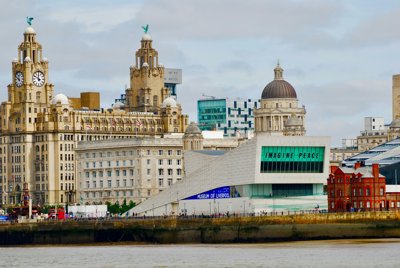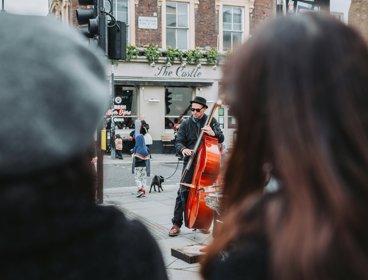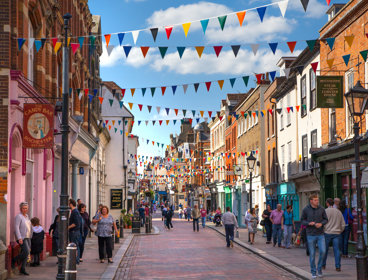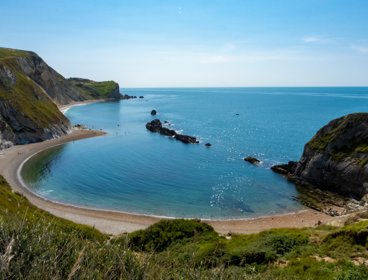December 2016
Broadly, this can be understood under the banner of heritage. In 2015 the Royal Society of the Arts (RSA), in conjunction with the Heritage Lottery Fund, announced for the first time, the launch of the Heritage Index. Through this research the RSA reveal how cultural assets and activities shape places for the people living there, and how these experiences can be used for future place making and marketing. The index is comprised of over 120 indicators, with local data available for 390 local authority areas across the UK’s four nations. The RSA hope to ‘give people a richer understanding of their place, so that they are inspired to get involved in shaping their place in the future’.
What is the RSA Heritage Index?
The Royal Society of the Arts (RSA) have collaborated with the Heritage Lottery Fund to analyse over 120 datasets to better understand the links between heritage and identity at a local scale, with a national overview. The RSA have gathered data over six domains of heritage:
-
historic built environment;
-
museums, archives and artefacts,
-
industrial heritage;
-
parks and open space,
-
landscape and natural heritage,
-
and cultures and memories.
The data ranges from length of canals and size of protected wildlife sites, through to the number of historic local business and the proportion of residents visiting museums and archives. The index is designed to facilitate debate about the value of place and how local heritage assets and activities can be harnessed for future development. The data can be accessed through online maps (for England, Wales, Northern Ireland, and Scotland), and downloadable data sets.
Explore the RSA data through downloadable data sets for England, Northern Ireland, Scotland, and Wales
“Heritage doesn’t speak for itself – it involves people playing a role to interpret historic resources, so that they are meaningful in the present day. Therefore, we consider that heritage activities are just as important as heritage assets”
The Heritage Index recognises not only material, or tangible history such as castles, museums and other buildings of historic interest but also, it recognises places with local food and drink products which have received special protected status from the European Commission, such as Melton Mowbray Pork Pies and Kentish Ale (see Protected Food Names) . More than this, the Heritage Index is concerned also, with recognising activities and participation in local communities: the amount of people who volunteer, the number of people visiting museums and the number of nights people spend on holiday in a local area. In essence then, the RSA suggest that heritage is ‘what people chose to make it’ (Thorbold, 2016). According to the RSA, areas with higher level of heritage, also report higher levels of well-being. These correlations are strongest when heritage is produce through local and community activities, rather than material assets.
See Jonathan Schifferes of the RSA explain how the Index could help Great Britain make better use of its heritage in order to improve local experience, from well-being to tourism
Is all Stilton Cheese made in Stilton? How can food names protect heritage and promote tourism in certain places? This paper in Area by geographer Dr Matthew J Rippon (2014) explores how the international Geographical Indications (GI) structure decides what is in, and out of, place and the links between local history, food production, tourism and place-development:
See also: The story of stilton cheese, Geography Directions (2014)
Where are the heritage hotspots in the UK?
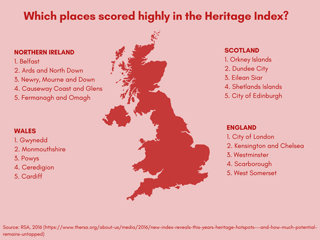
In 2015, the RSA compared heritage scores of all 325 English districts with their score in the Index of Multiple Deprivation and found no correlation. In 2015, several places scored highly in the Heritage Index despite being relatively poor communities. For example, relatively poor communities such as Burnley (33rd) and Barrow-in-Furness (15th) ranked highly. On the other hand, many affluent areas did not register for good results. For example, Basingstoke (319th) and Wokingham (278th).
The RSA found neither rural, nor urban bias. Though cities such as London performed well, with City of London and Kensington and Chelsea placing 1st and 2nd - both these places boast Universities, historic archives and world leading museums.
Interestingly, coastal regions rank especially well in the Index; with half of the top performing places possessing a coastline. Places such as Dorset’s Jurassic Coast score highly as a World Heritage site, owing to the abundance of activities that preserve and promote its unique landscape. Also, due to the array of rich naval and industrial histories those cities, such as Liverpool, boast. As such, outside of London, Liverpool is amongst the top large cities in England; as well as the natural significant asset of the River Mersey, the city has 23 businesses in the culture sector with a long history including: football clubs, music venues, cinemas and threats.
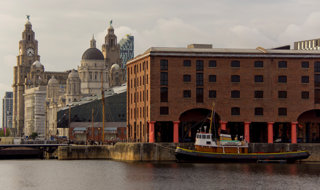
In 2015, it was reported widely in the press that the North West town of Warrington, Cheshire was ranked lowest in the index and therefore the “worst town for culture in Britain” (The Guardian, September 2015). This left the people of Warrington understandably upset, and the community has worked hard to have its assets recognised, such as: it’s home to England’s first industrial canal, during WW2 the largest US Army Air Force airfield outside of the US, and in 1987, it became home to the first IKEA store (Heritage Lottery Fund, 2016).
Britain’s Worst Places for Culture Named, The Independent, 2015
More case studies on how people identify with the places they live and work are available from the RSA, in partnership with the Heritage Lottery Fund.
Open data? How the Heritage Index was made
Although the Index features over 100 datasets, heritage is difficult to quantify and record. In order to create the Index, the RSA used open data and online platforms with information often produced by dedicated and enthusiastic volunteers. For example, the Index used platforms such as Open Plaques and Historypin, that crowdsource information over the internet, building up an extensive library of almost 10,000 plaques and 60,000 pins of historical information. The index was also supported by the Welsh government’s GIS portal, and the Scottish governments mapping of urban green space.
The index features over 100 datasets, but heritage is difficult to quantify and record. Questions that the RSA considered were: what if the physical legacy of place history is not considered valuable by local residents? In this situation, is it up to people in the local area to suggest additional datasets that reflect what is held valuable locally and what can be compared with other locations.
Using data skills in Geography? Resources on quantitative methods, supported by the Nuffield Foundation are available here
What can we learn about the value of place through the RSA Heritage Index?
As human geographer Tim Cresswell (2008) has suggested, “places, then, are particular constellations of material things that occupy a particular segment of space and have sets of meanings attached to them”. The Heritage Index shows us how place is shaped and produced by both material and representational geographies. So, material things (buildings, castles, pork pies) are more than just the passive recipients of cultural values and meanings but rather they also actively shape the “imaginative geographies” of place and place-making. The Index shows how external agencies attempt to quantify these experiences for future development and place-making activities. The Heritage Index is one such practice, but it also reflects the success of heritage and place-making agencies such as National Trust, English Heritage, and the European Commission, which establish and develop local places through national policies.
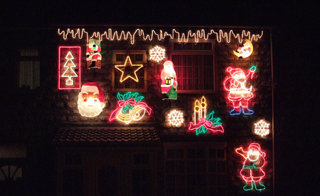
However, in doing so, are there certain experiences, or rather identities that may be excluded in these exercises? Cultural geographer Tim Edensor (2009) has suggested there is a tendency by external agencies to value certain creative practices and histories over more everyday, vernacular creativity, or geographies that may be difficult to quantify in terms of social, economic and cultural capital. Using the example of Christmas light displays in December, Edensor states that these practices are community minded acts that attempt to give places a distinctive local feel but they may not be recognised formally as ‘place-making’. Perhaps then, residents living in towns that have performed poorly in the Index may be able to offer alternative, or contrasting experiences and representations to those captured in this place-making exercise.
Conclusion
The Heritage Index draws attention to the spaces and activities that make places unique that give them their feel. In some situations, this can be harnessed to improve an area in economic, social and cultural terms. To do so, requires community and state help to preserve and sustain sites of interest. It is hoped by the Royal Society, that the Heritage Index will enable communities to do so and perhaps promote their local area to encourage tourism, and business. However, as geographers it is important to be critical of such techniques and to consider the research methods and data behind it, and engage with both place, and how places are represented, in a meaningful way.
Lesson Ideas
Look at your own borough, or area, do you feel the data is accurately representing this place?
THE RSA Heritage Index (maps and data are downloadable here)
Does it reflect your experience? Which other data may be useful? Think of two or three other categories.
Choose a location that is very different to where you live, but one you have heard of. Create a fact sheet on what makes this place special. Are you surprised by what you find? How does it compare to the geographical imagination you had of this place?
Choose a location that has not performed well in the index, and that may be, in some way, lacking heritage. Through independent research, explore why you think this place lacks heritage, and have you found anything that you think should be considered as making this place unique.
Links
THE RSA Heritage Index (maps and data are downloadable)
The Guardian, Warrington, worst town for culture in Britain?
Local Gov, Index reveals places with greatest heritage potential
Town improves in national heritage study 14 months after being shamed, Warrington Guardian
Gwynedd holds its top slot for heritage, ITV
Cresswell, T, (2008) Place: encountering geography as philosophy, Geography, Vol. 93, No. 3 pp. 132-139
Cloke, P., Crang, P. Goodwin, M. (2014) Introducing Human Geographies (3rd Edition). Routledge: London
Edensor, T., Millington, S. Illuminations, Class Identities and the Contested Landscapes of Christmas. Sociology. 43 (1) pp. 103 – 121.
Edensor, T. Leslie, D. Millington, S. (2009) Spaces of Vernacular Creativity: Rethinking the Cultural Economy. Routledge: London.
Rippon, M. (2014) what is the geography of Geographical Indications? Place, production methods and Protected Food Names, Area. 46 (2) pp. 154 -162
Key Words
Cultural capital: the collection of skills objects and experiences that one acquires through being part of a particular social class. Certain forms of cultural capital are valued over others, and may help or hinder one’s social mobility in a similar way to economic or social capital.
Heritage: valued objects and qualities such as historic buildings and cultural traditions that have been passed down from previous generations.
Imaginative geographies: the perception of spaces and places through images, texts and stories than construct an understanding or ‘imagination’ of what a place may be like (nationally, locally, regionally, and globally).
Vernacular creativity: everyday practices such as gardening, or craft classes, that are performed in ordinary places such as community centres, or homes.
File nameFiles
File type
Size
Download
